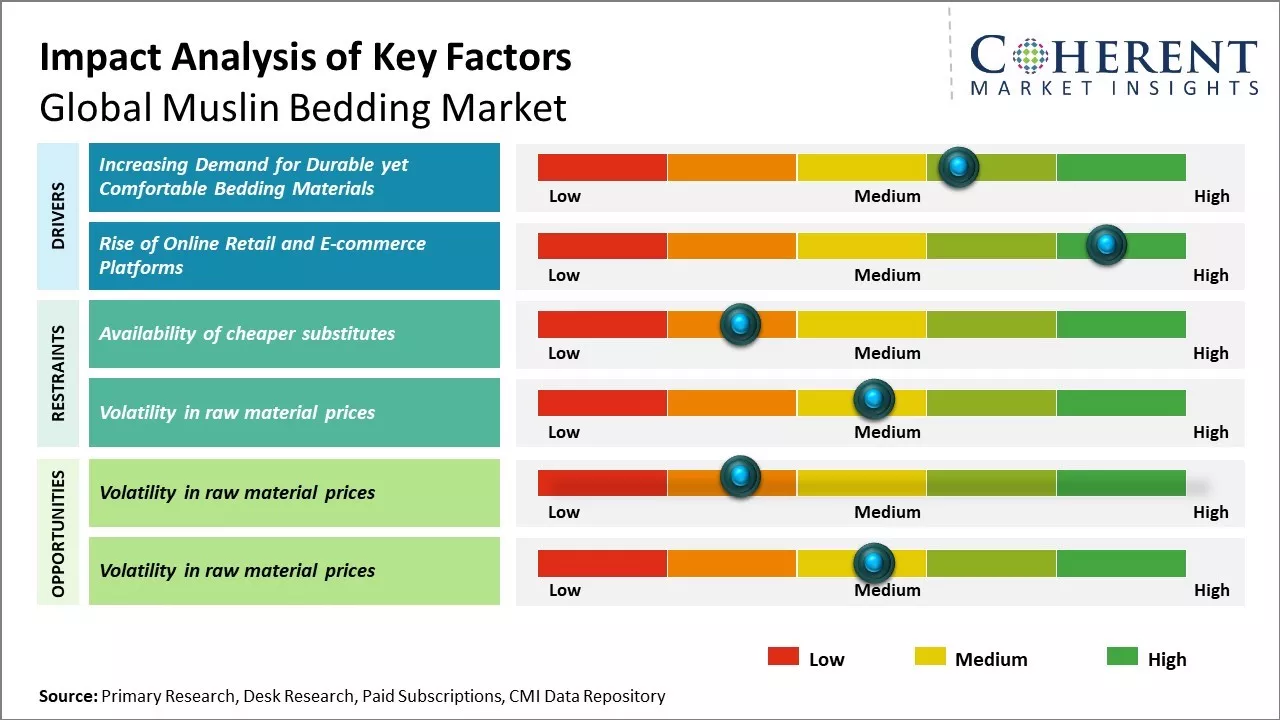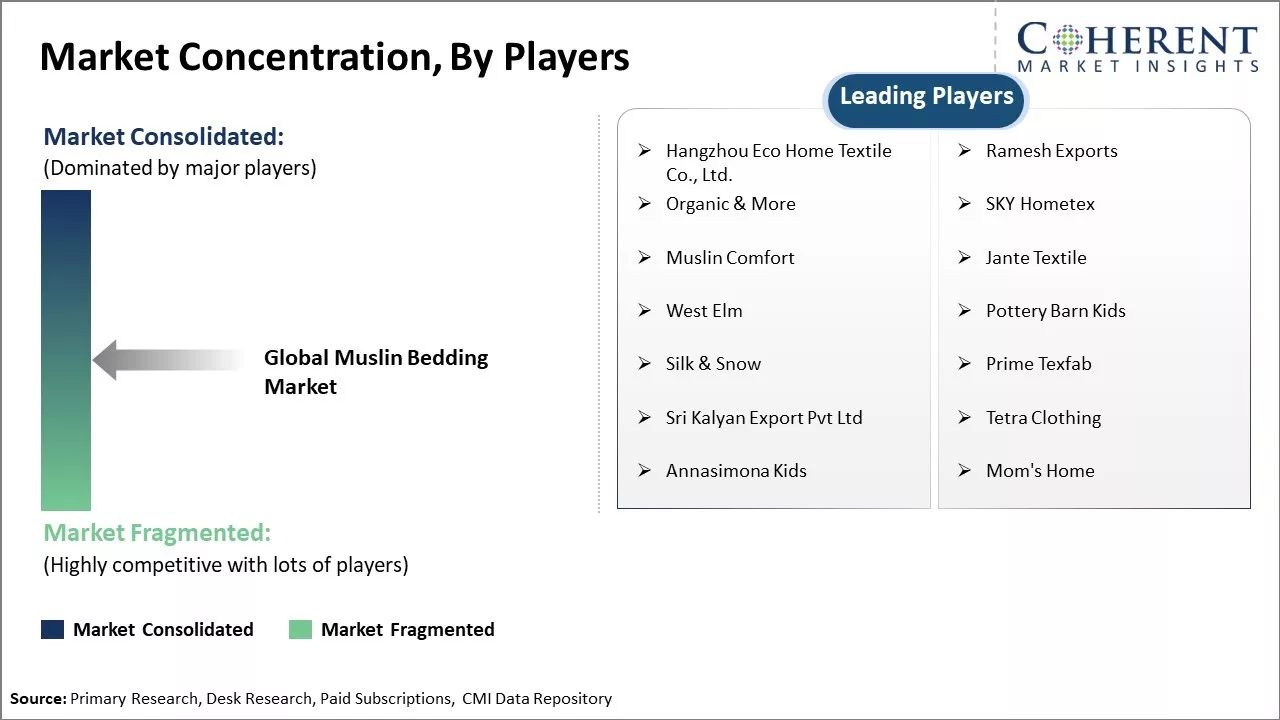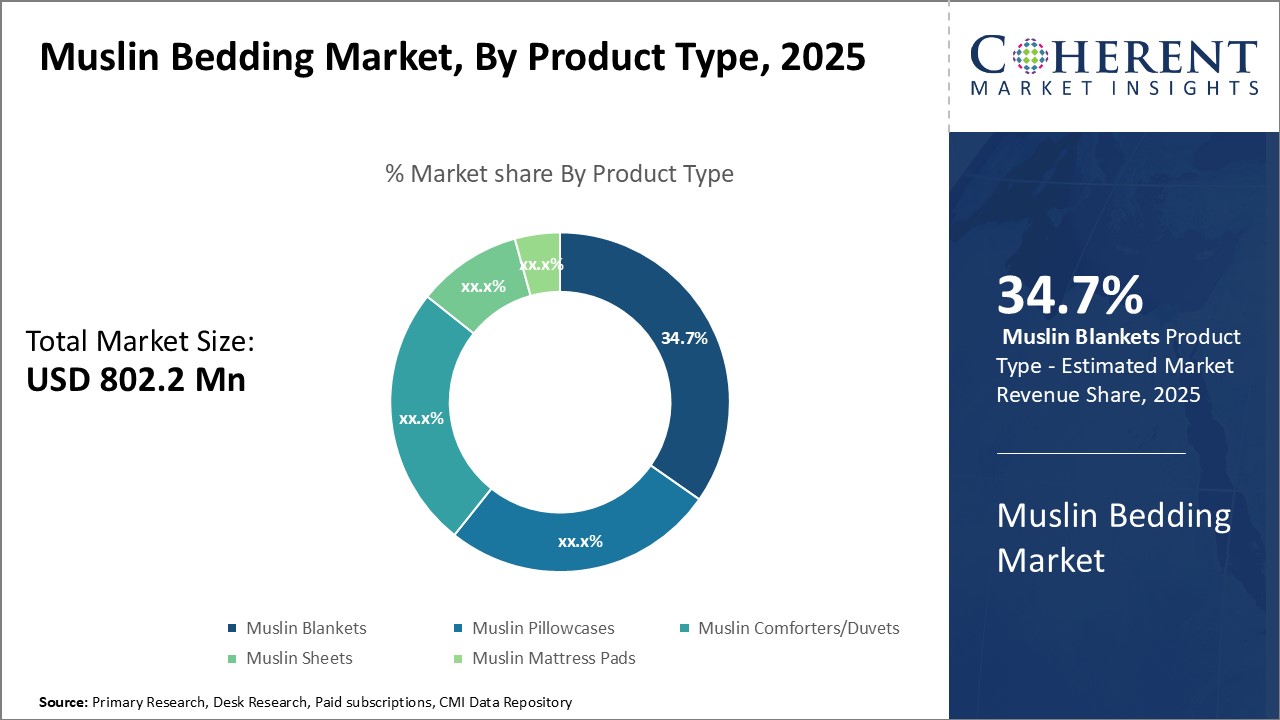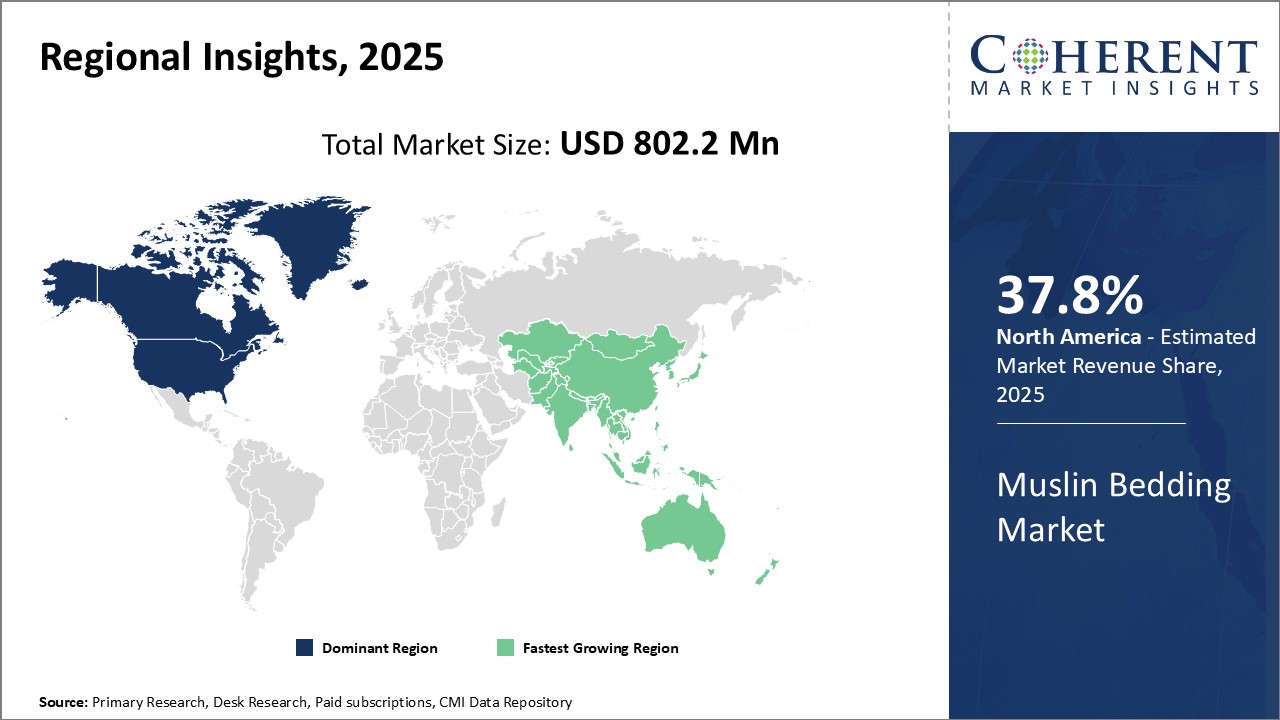Muslin Bedding Market Size and Trends
The muslin bedding market is estimated to be valued at USD 802.2 Mn in 2025 and is expected to reach USD 1,323.2 Mn by 2032, growing at a compound annual growth rate (CAGR) of 7.4% from 2025 to 2032.

Discover market dynamics shaping the industry: Download Free Sample
The global muslin bedding market has been witnessing notable growth in the past few years. The increasing consumer spending on luxury and high quality bedding products and rising demand for environment-friendly fabrics are some of the key factors driving the market growth. Moreover, the fabric is lightweight, breathable and softer on skin as compared to cotton which is gaining popularity among consumers. However, volatile prices of raw materials may hamper the market growth. Nevertheless, increasing adoption of muslin bedding products in developing countries is expected to offer lucrative opportunities for market players over the forecast period.
Increasing Demand for Durable yet Comfortable Bedding Materials
The global demand for bedding materials that can withstand regular usage yet offer supreme levels of breathability and comfort has been steadily rising in recent years. Consumers across regions now place higher emphasis on opting for bedroom textiles that not just look good but also maintain their quality over prolonged usage. Muslin bedding products have emerged as a popular choice as they score well on both these counts. Made from 100% cotton fabric, muslin is extremely durable, and can withstand hundreds of washes without pilling or tearing. At the same time, its lightweight construction allows sufficient airflow, making it a cool and comfortable option for hot weather conditions. The breathable nature of muslin also appeals to a section of consumers who suffer from allergies or sensitive skin. Muslin fabrics do not trap heat or moisture against the skin like some synthetic alternatives. This hypoallergenic quality has further increased muslin's appeal in the premium bedding space. Additionally, the natural production process of muslin gives it a soft texture that feels pleasant against the skin. Leading bedding brands are cognizant of these proliferating demands and preferences of modern consumers. They have thus expanded their portfolio to include high-thread count muslin sheet sets, duvets, and bedcovers. The eco-friendly nature of muslin fabric sourced from natural cotton crops also aligns well with the rising emphasis on sustainable living.
Market Concentration and Competitive Landscape

Get actionable strategies to beat competition: Download Free Sample
Rise of Online Retail and E-commerce Platforms
The proliferation of online shopping platforms has radically transformed the global retail landscape over the past decade. Whereas consumers previously relied primarily on brick-and-mortar stores for purchasing bedding and home textile products, the emergence of robust e-commerce channels has provided them wider alternatives. Online retailers now offer extensive collections of bed linens, pillowcases, and comforters from a variety of materials including muslin. Browsing and selecting from a diverse virtual inventory is more convenient than visiting different physical outlets. Furthermore, e-retailers can pass on substantial savings from lower overhead costs to consumers in the form of competitive pricing. Customers appreciating the simplicity and breathability of muslin bedding were thus able to discover these options while browsing online retail categories. Established muslin brands as well as small producers gained access to a global customer base by listing their products on virtual marketplace platforms.
Key Takeaways of Analyst:
The global muslin bedding market has potential for steady growth in the coming years. Some of the key drivers for this market include increasing demand for eco-friendly and breathable fabrics for bedding.
Muslin cotton fabrics are naturally hypoallergenic and help maintain temperature neutrality during sleep. This makes muslin popular among consumers concerned about their environmental footprint as well as those suffering from allergies.
Rising prices of raw cotton and disruptions in the supply chain may restrain the market growth to some extent. Increased demand has pushed up cotton prices, which manufacturers will likely pass on to consumers in the form of higher prices. Production halts due to COVID-19 also temporarily impacted the supply of muslin fabrics.
Market Challenges: Availability of cheaper substitutes
Availability of cheaper substitute bedding options is presenting a major restraint for the growth of the global muslin bedding market. Muslin fabric, which is typically made from cotton, faces strong competition from polyester and other synthetic fabric based substitutes. These artificial substitutes offer comparable comfort and texture at a much lower price point compared to muslin. Synthetic fabrics have emerged as popular alternatives for several reasons. Their production involves lower input costs since synthetic fibers can be mass-produced through oil refining. This allows bed sheets, pillow cases, duvets and other bedding made from polyester or blends to be offered to consumers at competitive retail pricing, often 20-30% cheaper than equivalent muslin items. Synthetic fabrics are also perceived as being more durable and easy to maintain compared to natural fibers. They retain their shape for longer without shrinking, fading or requiring frequent washing. This reduces long term maintenance costs.
Market Opportunities: Volatility in raw material prices
Volatility in raw material prices presents a great opportunity for companies in the global muslin bedding market. Muslin is primarily made from cotton which is prone to fluctuations in price depending on climatic conditions and various other factors affecting crop yield. Recent years have seen spikes in cotton prices due to droughts in major cotton producing regions. However, companies that plan strategically can leverage this volatility. By accurately forecasting cotton price trends and maintaining optimum inventory levels, muslin bedding manufacturers can insulate themselves from sudden price rises. They can negotiate bulk raw material purchases during price dips and even secure supply contracts to safeguard future production. This allows for price stability in end products. Additionally, investing in backward integration can help gain greater control over raw materials costs. Companies establishing their own cotton cultivation or tie-ups with co-operatives achieves better price negotiation power. Furthermore, backward integration opens avenues to market organic, pesticide-free cotton muslin bedding at a premium. The volatile prices also encourage innovation in raw material sourcing. Companies are exploring use of alternative natural fibers that are less prone to market fluctuations. Examples include using modal fiber derived from beech trees or Tencel made from wood pulp. Blending cotton with modal or tencel has proven to provide equivalent softness while balancing costs. This diversification in raw materials helps companies insulate their margins long-term.

Discover high revenue pocket segments and roadmap to it: Download Free Sample
Insights, by Product Type: Consumer Comfort and Versatility
In terms of product type, muslin blankets is expected to contribute 34.7% share of the market in 2025, owing to their widespread appeal amongst consumers. Muslin blankets are valued for their breathability and softness, making them extremely comfortable even in warm weather. Their light and airy fabric brings a sense of coolness under the blankets without compromising on warmth. Muslin blankets mold well to the shape of the body and drape nicely for a cozy sleep experience. Their versatility also adds to their popularity. Muslin blankets can be used throughout the year - as regular blankets during winters, throw blankets for lounging, and even makeshift picnic blankets. The material is durable enough for everyday use yet lightweight enough to be packed and carried easily during travel. Families particularly appreciate muslin blankets as decorative accents and play blankets for kids. Overall, muslin blankets deliver comfort and versatility at an affordable price point, driving their leadership in the product type segment.
Insights, by End Use: Comfort of Home
In terms of end use, the residential segment is expected to contribute 39.4% share of the muslin bedding market in 2025, owing to consumers' preference for premium home textiles. A comfortable bed and bedding remains a top priority for residential users looking to unwind and relax in the comfort of their own home. Muslin sheets are favored for their breathable qualities which keep sleep cool and cozy through the night. Muslin comforters and duvets provide an elegant yet laidback aesthetic suited for casual indoor spaces like living rooms and bedrooms. The all-natural material also appeals to health-conscious homeowners seeking toxin-free décor elements. As more people spend increased time at home due to changing lifestyles, demand will continue growing for high-quality muslin products that enhance comfort, wellness, and style within the home.
Insights, by Distribution Channel: Trust and Convenience
In terms of distribution channel, specialty stores is expected to hold 40.2% share of the muslin bedding market in 2025, due to advantages in customer service. Shoppers rely on specialty retail outlets to provide trusted guidance from experienced staff well-versed in various textile attributes like thread count, weave structure, etc. Hands-on product displays help customers understand qualities like breathability, sheen, and durability which are difficult to judge from pictures online. Many stores also offer personalized services around fit, stylish styling ideas, and ongoing after-sales support, fostering customer loyalty. While online and department stores provide convenience, specialty stores have established long-term relationships with an aging customer base who appreciate the personalized in-store experience when making sizable investments in quality bed and bath ensembles. This positions brick-and-mortar specialty channels strongly even as omni-channel trends evolve.
Regional Insights

Need a Different Region or Segment? Download Free Sample
North America has established itself as the dominant region in the global muslin bedding market. The region is expected to account for 37.8% share in 2025. With the presence of major manufacturers and retailers, countries like the U.S. and Canada account for sizeable shares. The region enjoys strong demand backed by high disposable incomes and changing consumer preferences towards organic and eco-friendly textiles. Moreover, extensive R&D activities have enabled North American companies to introduce innovative product lines catering to niche customer segments. Major manufacturers focus on offering customizable products and leveraging online sales platforms to strengthen their positions in the region. Strong distribution networks across various channels ensure wide availability and easy access for customers. Supportive trade policies have also boosted intra-regional and international trade over the years. North America is a prominent exporter and maintains a large surplus, while also catering to growing import demand from emerging markets.
Among developing regions, Asia Pacific is poised to witness the fastest growth in the muslin bedding market over the coming years. Countries like India and Bangladesh have established themselves as important hubs for textile production and exports on the back of favorable business environments and availability of raw materials as well as workforce. Asia Pacific caters to a significant portion of global demand through exports and is gaining increasing recognition for high-quality products. Rising living standards and growing spending power of South Asia's expanding middle class are fueling domestic demand as well. Moreover, supportive government policies focused on promoting the manufacturing sector and easing trade are encouraging local manufacturing and exports. Local companies catering to the large domestic demand are gradually expanding their international footprint. Significant investment in infrastructure and simplified trade policies have made South Asian nations integral nodes in global supply chains as well. The region has the potential to emerge as an important market globally going forward owing to continued economic growth and development.
Market Report Scope
Muslin Bedding Market Report Coverage
| Report Coverage | Details | ||
|---|---|---|---|
| Base Year: | 2024 | Market Size in 2025: | USD 802.2 Mn |
| Historical Data for: | 2020 To 2024 | Forecast Period: | 2025 To 2032 |
| Forecast Period 2025 to 2032 CAGR: | 7.4% | 2032 Value Projection: | USD 1,323.2 Mn |
| Geographies covered: |
|
||
| Segments covered: |
|
||
| Companies covered: |
Hangzhou Eco Home Textile Co., Ltd. , Ramesh Exports, Organic & More, SKY Hometex, Muslin Comfort, Jante Textile, West Elm, Pottery Barn Kids, Silk & Snow, Prime Texfab, Sri Kalyan Export Pvt Ltd, Tetra Clothing, Annasimona Kids, and Mom's Home |
||
| Growth Drivers: |
|
||
| Restraints & Challenges: |
|
||
Uncover macros and micros vetted on 75+ parameters: Get instant access to report
Muslin Bedding Industry News
- In 2017, ubbi launches newest product; muslin blanket buddy
*Definition: The muslin bedding market refers to the industry of manufacturing and selling various types of bedding products made from muslin fabric, such as bed sheets, pillowcases, duvet covers, mattress protectors, blankets, and throws. Muslin is a very breathable and lightweight fabric which makes the bedding cool and comfortable to sleep in warm weather. The muslin bedding market caters to customers looking for affordable and soft bedding options suited for hot climates.
Market Segmentation
- Product Type Insights (Revenue, USD Mn, 2020 - 2032)
- Muslin Sheets
- Muslin Pillowcases
- Muslin Comforters/Duvets
- Muslin Blankets
- Muslin Mattress Pads
- End-use Insights (Revenue, USD Mn, 2020 - 2032)
- Residential
- Hotels & Hospitality
- Hospitals & Healthcare
- Others (e.g. RV, Cruise Ships)
- Distribution Channel Insights (Revenue, USD Mn, 2020 - 2032)
- Specialty Stores
- Departmental Stores
- Online Retailers
- Direct Sales
- Regional Insights (Revenue, USD Mn, 2020 - 2032)
- North America
- U.S.
- Canada
- Latin America
- Brazil
- Argentina
- Mexico
- Rest of Latin America
- Europe
- Germany
- U.K.
- Spain
- France
- Italy
- Russia
- Rest of Europe
- Asia Pacific
- China
- India
- Japan
- Australia
- South Korea
- ASEAN
- Rest of Asia Pacific
- Middle East & Africa
- GCC Countries
- Israel
- Rest of Middle East & Africa
- North America
- Key Players Insights
- Hangzhou Eco Home Textile Co., Ltd.
- Ramesh Exports
- Organic & More
- SKY Hometex
- Muslin Comfort
- Jante Textile
- West Elm
- Pottery Barn Kids
- Silk & Snow
- Prime Texfab
- Sri Kalyan Export Pvt Ltd
- Tetra Clothing
- Annasimona Kids
- Mom's Home
Share
Share
About Author
Yash Doshi is a Senior Management Consultant. He has 12+ years of experience in conducting research and handling consulting projects across verticals in APAC, EMEA, and the Americas.
He brings strong acumen in helping chemical companies navigate complex challenges and identify growth opportunities. He has deep expertise across the chemicals value chain, including commodity, specialty and fine chemicals, plastics and polymers, and petrochemicals. Yash is a sought-after speaker at industry conferences and contributes to various publications on topics related commodity, specialty and fine chemicals, plastics and polymers, and petrochemicals.
Missing comfort of reading report in your local language? Find your preferred language :
Transform your Strategy with Exclusive Trending Reports :
Frequently Asked Questions
EXISTING CLIENTELE
Joining thousands of companies around the world committed to making the Excellent Business Solutions.
View All Our Clients
